单核细胞对肺动脉高压因果效应的三角测量证据:一项孟德尔随机研究和NHANES的结果
IF 3.1
3区 医学
Q2 CARDIAC & CARDIOVASCULAR SYSTEMS
引用次数: 0
摘要
背景先前的研究表明,循环白细胞(WBC)计数与肺动脉高压(PAH)的发展之间存在关联,但因果关系尚不清楚。本研究旨在探讨循环白细胞计数与多环芳烃之间的因果关系。方法使用欧洲血统全基因组关联研究(GWAS)数据集进行孟德尔随机化,评估白细胞计数对多环芳烃的影响。WBC亚型计数的汇总统计数据来自血细胞联盟,PAH的数据来自FinnGen GWAS结果。此外,利用国家健康和营养检查调查(NHANES)的数据进行了一项横断面观察性研究,以探讨白细胞计数与PAH之间的关系,涉及15835名参与者的样本量。结果smr结果显示单核细胞计数是PAH的危险因素(OR = 1.21, 95% CI 1.05 ~ 1.40, P = 0.007), IVW荟萃分析支持这一结论,敏感性分析显示MR结果的可靠性(OR = 1.21, 95% CI 1.10 ~ 1.36, P = 0.0009)。基于NHANES的一项横断面研究也支持单核细胞计数与多环芳烃之间的关联。结论本研究显示PAH风险增加与单核细胞计数之间存在因果关系,为单核细胞在PAH中的作用提供了新的见解。然而,需要进一步的研究来验证这一发现。本文章由计算机程序翻译,如有差异,请以英文原文为准。
Triangulation evidence for the causal effect of monocytes on pulmonary artery hypertension: a Mendelian randomization study and results from NHANES
Background
Previous research has indicated an association between circulating white blood cell (WBC) counts and the development of pulmonary arterial hypertension (PAH), however a causal relationship is unclear. This study aimed to investigate the causal link between circulating WBC counts and PAH.
Methods
We used the genome-wide association study (GWAS) datasets of European ancestry to perform Mendelian randomization to assess the effects of WBC counts on PAH. Summary statistics for WBC subtype counts were obtained from the Blood Cell Consortium, and data for PAH were sourced from FinnGen GWAS results. Furthermore, a cross-sectional observational study was conducted using data from the National Health and Nutrition Examination Survey (NHANES) to explore the relationship between WBC counts and PAH, involving a sample size of 15,835 participants.
Results
MR results showed that monocyte count was a risk factor for PAH (OR = 1.21, 95 % CI 1.05–1.40, P = 0.007), which was supported by a meta-analysis of IVW, and sensitivity analyses revealed the reliability of the MR results (OR = 1.21, 95 % CI 1.10–1.36, P = 0.0009). The association between monocyte count and PAH was also supported by a cross-sectional study based on NHANES.
Conclusions
This study shows a causal relationship between increased risk of PAH and monocyte counts, providing new insights into the role of monocytes in PAH. However, further studies are needed to validate this finding.
求助全文
通过发布文献求助,成功后即可免费获取论文全文。
去求助
来源期刊

Respiratory medicine
医学-呼吸系统
CiteScore
7.50
自引率
0.00%
发文量
199
审稿时长
38 days
期刊介绍:
Respiratory Medicine is an internationally-renowned journal devoted to the rapid publication of clinically-relevant respiratory medicine research. It combines cutting-edge original research with state-of-the-art reviews dealing with all aspects of respiratory diseases and therapeutic interventions. Topics include adult and paediatric medicine, epidemiology, immunology and cell biology, physiology, occupational disorders, and the role of allergens and pollutants.
Respiratory Medicine is increasingly the journal of choice for publication of phased trial work, commenting on effectiveness, dosage and methods of action.
 求助内容:
求助内容: 应助结果提醒方式:
应助结果提醒方式:


